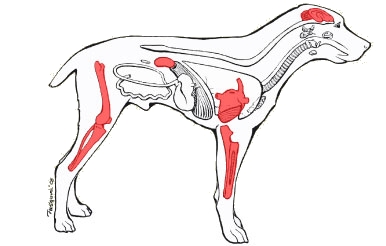Lyme Disease and Pets
Lyme disease is not only a threat to humans, but manifests in dogs and, to a lesser extent, in horses, cattle, and cats, while many wildlife mammals and birds become subclinically infected and serve as reservoirs for tick infection.
Did you just find a tick on yourself or a loved one? TickCheck can test your tick and determine whether it carries the bacteria that transmit Lyme disease and other tick-borne infections.
Lyme disease in Dogs 🐕
What are the signs and symptoms of Lyme disease in dogs?
In contrast to human cases of Lyme disease, where three different stages are well known, Lyme disease in dogs is primarily and acute or subacute arthritis. The acute form may be transient and may recur in some cases. The devastating chronic stage in humans with systemic disease has rarely been seen in dogs.

More severe, rare cases can affect the heart, kidney, or brain.
Dogs show sudden lameness and sometimes signs of severe pain. One or more joints may be involved. Joints are often swollen, hot, and painful upon manipulation. Dogs may have fever and be off-feed and lethargic. Some become severely depressed and are reluctant to move. Lameness may recur after a period of recovery lasting several weeks.
Lameness in dogs occurs an average of two to five months after tick exposure.
The first stage of human Lyme disease, a skin rash called erythema chronica migrans, is rarely seen in dogs. Some symptoms associated with the later stages of Lyme disease in humans have also been reported in rare instances in dogs. They include heart block, kidney failure, and neurological changes such as seizures, aggression, and other behavior changes.
What is the likelihood of a dog will contract Lyme disease?
The proportion of infected dogs that develop clinical disease is far smaller than it is for humans. Serological studies suggest that while more than 75 percent of the dog population in hyper-endemic areas may be exposed to infected ticks, only about five percent of those exposed actually develop clinical signs that might be attributable to Lyme disease.
Within endemic areas, “hot spots” of tick infestation where dogs have a much greater probability of acquiring an infection are intermingled with non-infested areas where the habitat is not favorable to the vector tick. There may be age, breed, and genetic differences in the susceptibility of dogs to Lyme disease, but little is known yet about these factors.
Lyme Disease in Cats 🐈
Most cats show little to no symptoms of being infected with Lyme disease. While there is a potential for cats to be infected with Lyme disease, it is not commonly found. The symptoms in cats are similar to those in dogs. Symptoms include fever, fatigue, difficulty breathing, loss of appetite, lethargy and swelling in the muscles and joints. It can also affect the kidneys, nervous system and heart. A cat can be treated with antibiotics and if treated early, they have a higher chance of recovering. A delay in treatment can cause the need for prolonged veterinary care.
Lyme Disease in Horses 🐎
Lyme disease in horses is not a common equine disease, but a horse can be infected with it and it can have a serious impact on the health of the horse. The typical symptoms a horse with Lyme disease can show include lameness, arthritis, dermatitis, fever, loss of appetite, fatigue and sometimes neurological problems have been seen. When arthritis develops, it will affect one or several joints. It sometimes is sporadic, but it can also become chronic. If left untreated, Lyme disease can have a long-term effect and complications that can include joint, skin, nervous system and vision problems.
It can be difficult for a vet to diagnose a horse with Lyme disease because the related symptoms can point to a variety of diseases.
In contrast to humans or dogs that have Lyme disease, horses have not shown heart, liver or kidney problems as a result of being infected.
Lyme Disease in Cattle 🐄
On occasion cattle have been found to be infected with Lyme disease. Presently there is no set pattern when it comes to symptoms, diagnosis and treatment. In the early stage of infection cattle can develop fever, stiffness and swollen joints, lameness and a decrease in milk production. As with horses, the symptoms cattle can show are very similar to other common diseases that are found amongst cattle. Symptoms can also vary from cow to cow.
Sources
USDA www.ars.usda.gov
Baker Institute for Animal Health at Cornell University's College of Veterinary Medicine www.vet.cornell.edu
Merk Veterinary Manual www.merkvetmanual.com
